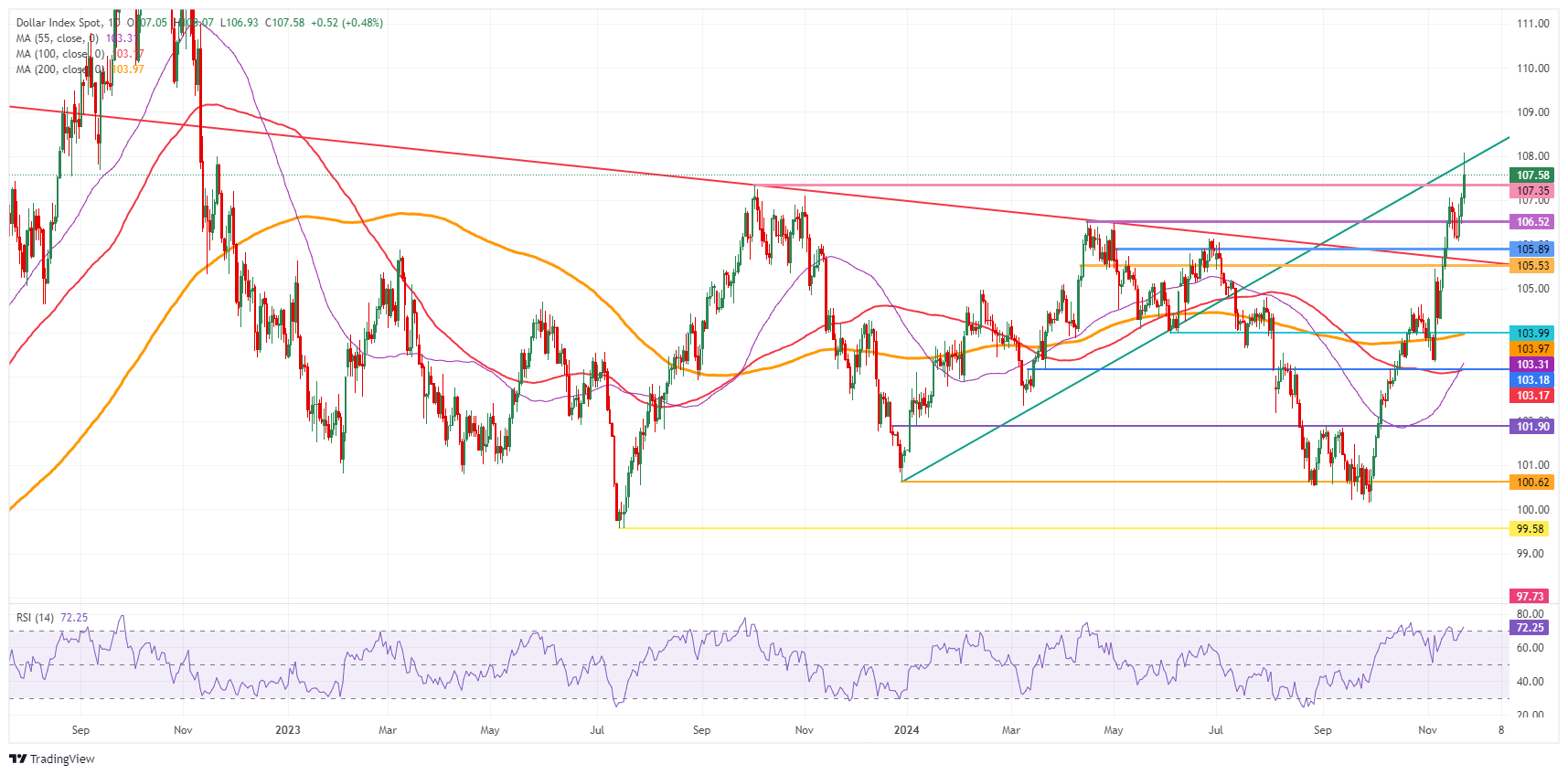US Dollar surges to two-year high as Eurozone PMIs disappoint

- The US Dollar Index (DXY) rallied to a fresh two-year high after Eurozone PMI data suggested the region’s economy is contracting.
- The US Dollar is also supported by safe-haven flows amid escalating geopolitical risks in the Russia-Ukraine war.
- The US Dollar Index pops above 108.00 and eases slightly afterward.
The US Dollar (USD) jumps on Friday to its highest level in two years, with the DXY US Dollar Index popping above 108.00, as Purchasing Managers Index (PMI) data for the Eurozone signaled that the region’s economy fell back into contraction in November. The data weighed heavily on the Euro (EUR) – the main foreign currency forming the DXY – as it could mean more interest rate cuts ahead by the European Central Bank (ECB) in order to support growth.
Earlier on Friday, the final reading for the German Gross Domestic Product (GDP) was downwardly revised to 0.1%, which means that the Eurozone’s largest economy barely grew in the third quarter.
Adding to the Euro weakness, the US Dollar keeps getting support from safe-haven flows due to the escalating war between Russia and Ukraine. According to Yahoo News, Russia has put a US military base in Poland at the top of its priority list of targets for the next retaliations.
The US economic calendar features the preliminary S&P Global PMI readings for November as well. After the big miss from the European PMI numbers, robust figures for the US could fuel further US Dollar strength. Apart from that, the final reading for the University of Michigan Consumer Sentiment survey will also be released.
Daily digest market movers: It could turn ugly this Friday
- European PMI data presented a bleak picture for the Eurozone and its main economies. The Eurozone Composite PMI fell to 48.1 from 50, missing expectations and signaling that the region’s economy is contracting. The data suggested that the services sector fell into contraction, while the downturn in the manufacturing sector gained traction.
- Individual PMI data for both France and Germany also broadly missed expectations. For Germany, the data suggests that economic activity contracted at the quickest rate in nine months, while in France the contraction was the steepest since January.
- Germany’s Gross Domestic Product (GDP) reading for the third quarter came in at 0.1%, downwardly revised from 0.2% in the preliminary reading.
- At 14:45 GMT, S&P Global will release the preliminary Purchasing Managers Index (PMI) reading for the US:
- The Manufacturing component is expected to edge up to 48.8 from 48.5 previously, remaining in contraction.
- The Services PMI is expected to increase to 55.3 from 55.0 previously.
- The University of Michigan survey will publish its final November reading at 15:00:
- Consumer Sentiment is expected to come in a bit better at 73.7 against the preliminary reading of 73.0.
- The Inflation expectations are expected to remain at 3.1%.
- Equities are again looking for direction, with Chinese equities being slaughtered this Friday. The main losses are in the Shanghai Composite Index, which fell over 3% at its closing bell. European equity indices fall, while US equity futures post minor gains.
- The CME FedWatch Tool is pricing in another 25 basis points (bps) rate cut by the Fed at the December 18 meeting by 55.9%. A 44.1% chance is for rates to remain unchanged. While the interest-rate cut scenario is still the most probable, traders have pared back some of the rate-cut bets compared with a week ago, when a rate-cut possibility was at 62%.
- The US 10-year benchmark rate trades at 4.40%, sliding further away from the high printed on Friday at 4.50%.
US Dollar Index Technical Analysis: Headline risks with data releases
The US Dollar Index (DXY) is edging up, sparked by those European PMI numbers that reveal the whole Eurozone is in contraction. Pending US PMI data to be released later today, it looks like the performance gap between Europe and the US just got bigger in favor of the United States. Look out for some profit-taking ahead of the weekend, which might trigger a fade by the US closing bell on Friday evening.
With the fresh breakout, a daily close above 107.00 will be key now before heading into the weekend. A fresh two-year high is now seen at 108.07, which is the statistical level to beat next. Further up, the 109.00 big figure level is the next one in line to look at.
The first level on the downside is 105.89, the pivotal level since May 2. A touch lower, the pivotal 105.53 (April 11 high) should avoid any downturns towards 104.00. Should the DXY fall all the way towards 104.00, the big figure and the 200-day Simple Moving Average at 103.95 should catch any falling knife formation.

US Dollar Index: Daily Chart
US Dollar FAQs
The US Dollar (USD) is the official currency of the United States of America, and the ‘de facto’ currency of a significant number of other countries where it is found in circulation alongside local notes. It is the most heavily traded currency in the world, accounting for over 88% of all global foreign exchange turnover, or an average of $6.6 trillion in transactions per day, according to data from 2022. Following the second world war, the USD took over from the British Pound as the world’s reserve currency. For most of its history, the US Dollar was backed by Gold, until the Bretton Woods Agreement in 1971 when the Gold Standard went away.
The most important single factor impacting on the value of the US Dollar is monetary policy, which is shaped by the Federal Reserve (Fed). The Fed has two mandates: to achieve price stability (control inflation) and foster full employment. Its primary tool to achieve these two goals is by adjusting interest rates. When prices are rising too quickly and inflation is above the Fed’s 2% target, the Fed will raise rates, which helps the USD value. When inflation falls below 2% or the Unemployment Rate is too high, the Fed may lower interest rates, which weighs on the Greenback.
In extreme situations, the Federal Reserve can also print more Dollars and enact quantitative easing (QE). QE is the process by which the Fed substantially increases the flow of credit in a stuck financial system. It is a non-standard policy measure used when credit has dried up because banks will not lend to each other (out of the fear of counterparty default). It is a last resort when simply lowering interest rates is unlikely to achieve the necessary result. It was the Fed’s weapon of choice to combat the credit crunch that occurred during the Great Financial Crisis in 2008. It involves the Fed printing more Dollars and using them to buy US government bonds predominantly from financial institutions. QE usually leads to a weaker US Dollar.
Quantitative tightening (QT) is the reverse process whereby the Federal Reserve stops buying bonds from financial institutions and does not reinvest the principal from the bonds it holds maturing in new purchases. It is usually positive for the US Dollar.




